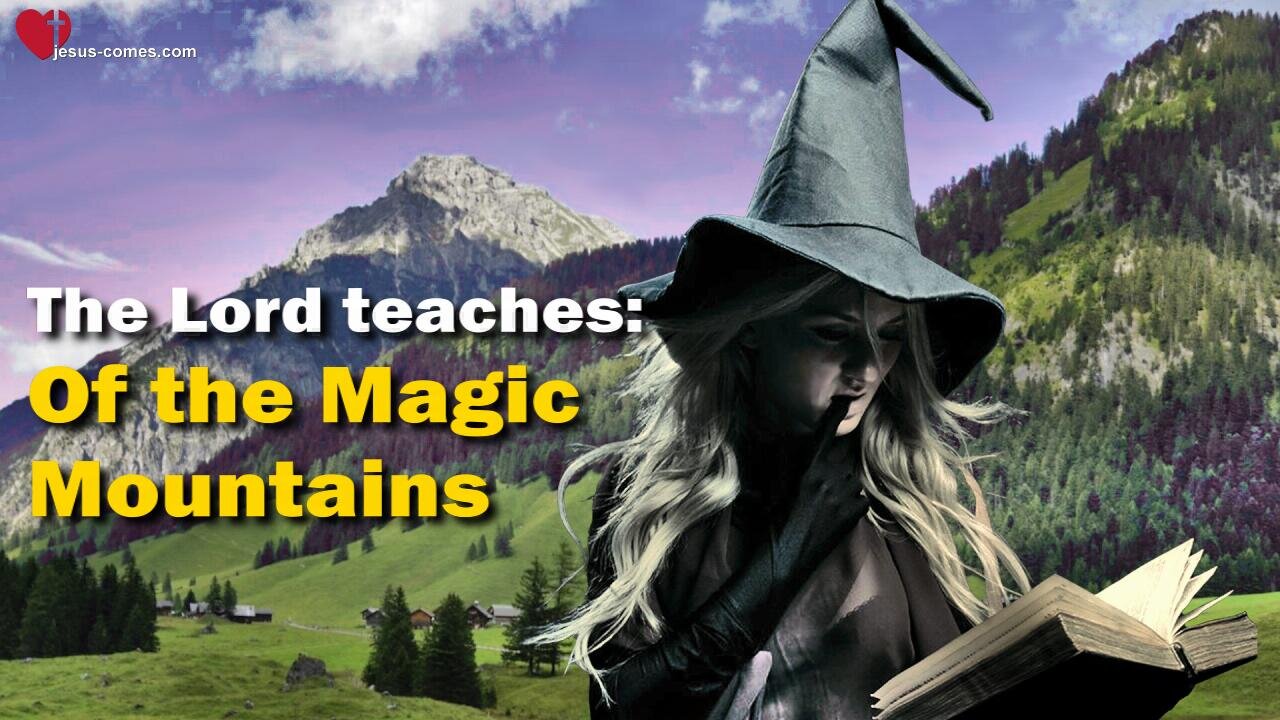Premium Only Content

Of the Magic Mountains... Jesus Christ teaches ❤️ The spiritual Earth thru Jakob Lorber 36/85
Text & Audio... https://jesus-comes.com/index.php/2023/10/30/zauberberge-magic-mountains/
Read online... https://search.jesus-comes.com/index.php?title=EARTH-36
Channel Overview... https://jesus-comes.com/index.php/2022/10/16/kanalubersicht-channel-overview/
The Third Testament in various Languages... https://jesus-comes.com/index.php/das-dritte-testament-the-third-testament-el-tercer-testamento/
Jesus' Revelations thru Jakob Lorber... https://jesus-comes.com/index.php/category/english/jakob-lorber-pdfs/
Jesus' Revelations thru Gottfried Mayerhofer... https://jesus-comes.com/index.php/category/english/53-sermons-of-jesus/
LoveLetters from Jesus... https://jesus-comes.com/index.php/liebesbriefe-von-jesus-love-letters-from-jesus/
Trumpet Call of God... https://awakeningforreality.com/latest-video-and-audio-letters-neuste-video-und-audio-briefe/
The spiritual Earth
Chapter 36: Of the Magic Mountains
(February 23, 1847)
1. Even today, the peculiar names of the mountains, if not much else, testify to the fact that, in times past, clairvoyant people dwelled upon the mountains, individuals who were in contact with the spirits.
2. (1) In your country (i.e. Styria) there are many such mountains, even now containing within their names hints as to what happened in times past. In Carinthia, in Tyrol, in Switzerland, in Savoy, upon the mountains of Germany, and everywhere else with the presence of mountains, there are those whose names openly reveal what once took place upon them. Even your Schöckel is such a mountain, for it had received its name from a word of an old vernacular, the word “Schögeln” to be precise, roughly meaning “to make weather”.
(2) However, Schögler was also used to describe someone who could perform some of the arts of nature, practices like today’s sleight of hand. Even individuals dancing on rope or otherwise performing mighty leaps were called Schögler. This word, “Schögeln”, is an ancient Asian word, after which the magicians there are named as well, such as jugglers or jogles.
3. (1) In the German language, even today there is a common word, though admittedly somewhat obsolete, which derives from this old term, namely the word “Schock” (a large number, around 60), e.g. a Schock of people or a Schock of sheaves. Certain groups of people were called a “Schock” because they were usually thought to include an individual who knew a little more than the others, one who therefore was certainly a “Schögler”, and as such the crowd received the “Schock” description from him.
(2) Those who dwelled upon the mountains were also usually seen in groups, which is quite natural there, for it would not be advisable for isolated individuals to carry out work for which a single man’s strength would not suffice, and even if it did suffice, something might happen to the worker, and there would no one be around to help him. In earlier times, however, if the inhabitants of the valley spied such a small group of people upon a mountain, and, by chance, a small cloud above the peaks, they immediately believed those upon the mountain to be practicing magic, certainly responsible for making weather. Upon this Schöckel of yours, this is exactly what transpired in times past, and still does to this day, except for the weather making.
4. (1) This mountain was inhabited far earlier than the valleys, and its first name was “Freitauer”; but in later times, when the valleys began to be inhabited by more effeminate peoples, those valley dwellers soon began to suspect the mountain dwellers of being sorcerers, and the name “Freitauer” was soon changed into “Schöckel” or “Zauberberg” (Magic Mountain). There was a time, hardly even a hundred years ago, when this mountain was so notorious that no honest Christian ever dared to climb its uppermost peak, for all who were to any degree of a Catholic-Christian mind were warned most emphatically of the “Schöckel witch”.
(2) For this reason, its loftiest summit was deforested in order to deprive the Schöckel witch of her cover, so she could no longer hide from the consecrated powder she was shot at with from all sides. The weather hole can be seen to this day, but the fact that no weather was ever conjured there and that no witch ever inhabited the Schöckel hardly needs to be elaborated to you in any more detail. However, you may assume without a shadow of a doubt that, in earlier times, this mountain was, and still is today, inhabited by many so-called mountain spirits, with whom the old inhabitants of this mountain frequently had natural dealings, and were therefore much wiser than the valley dwellers. In truth, this mountain was once a volcano, and its apparent weather holes are nothing but craters that have remained open.
5. As was the case with the Schöckel, many other mountains in Styria first received their mysterious names in like manner, all of which the scope of this communication would not permit us to discuss. Thus the “Raxalpe” is of similar origin, for the word “Rax” is, in a way, apostrophised from “Racker” (varmint, rascal), in a sense, a little devil. The “Tote Weib” (Dead Woman) wears the meaning of its name upon its very sleeves, a most powerful portent of what this mountain once was, namely a territory of witches. Once a woman was intercepted by them, yet she refused to yield to their will, and so she was turned into a stone. With this transformation, of course, she was dead.
6. In later times, a hermitage was established further down, in which another woman was once found dead as well. Several other such legends have been associated with this mountain, though, of course, there is as much truth to all of them as the very lie itself. The reason for this continuous suspicion and the malignant naming scheme of such mountains is the same as has already been disclosed throughout the course of this enclosed memorable tale.
7. In the same vein, the “Hohe Schwab” (High Schwab) is also renowned as a magic mountain. Its name hails from a descendant, or emigrant, of Swabia, one of the most famed sorcerers to exist in this region. He wreaked havoc, until the nearby pilgrimage site (Maria-Zell), which you probably know, put an end to him. In like manner, there is the “Teufelsstein” (Devil’s Stone), and this one requires no further explanation. The “Predigerstuhl” (Preacher’s Chair) is of similar origin, for it was said that thereupon, Satan, in the flesh, once preached the rules of conduct to the warlocks.
8. Thus, “Grimming” is of an equally suspicious reputation as well. Especially suspicious, however, was the expansive “Tragelgebirge”, which forms the border between Salzburg, Upper Austria and Styria. In a way, the “Tragelgebirge” was an academic institution for sorcerers and wizards from all over Styria, Austria and Salzburg; Even today, the name carries an ominous weight, and no inhabitant of Altaussee or Ramsau, for instance, could be easily persuaded to ascend this barren mountain range, especially should he belong to the so-called lower class, the exception being marksmen who, ever so prudently, no longer take any stock in the idea of witches, but are all the more interested in the fat chamois that make their home upon this vast mountain range.
9. We could go over at least a few hundred more such mountains in Styria, but we shall be content with the ones mentioned so far. We will follow up with a few more mountains from Carinthia, Tyrol and even one from Switzerland, in the same manner as was done above, elucidating those that played an extraordinarily mystical role about 120 years ago.
-
 13:34
13:34
Jesus' Revelations thru Jakob Lorber English
1 year agoThis says God as Father to His Children ❤️ The Household of God thru Jakob Lorber
157 -
 LIVE
LIVE
SpartakusLIVE
4 hours agoShadow BANNED, but we PARTY ON || Friday Night HYPE
435 watching -
 2:00:53
2:00:53
Omar Elattar
2 hours agoGRANT CARDONE: “Will I Run for Governor?” | Trump EXPOSED | Bitcoin | $500 Billion Crisis!
13.9K1 -
 46:48
46:48
Glenn Greenwald
6 hours agoGlenn Takes Your Questions On Gaza, USAID, and More | SYSTEM UPDATE #403
55.2K39 -
 56:42
56:42
Candace Show Podcast
9 hours agoBecoming Brigitte: One Coincidence Too Many | Ep 3
136K157 -
 3:14:38
3:14:38
Nerdrotic
10 hours ago $2.06 earnedDisney Plus's Complete FAILURE! Fantastic Four Trailer, MCU Phase 5 Reveal | Friday Night Tights 340
131K36 -
 1:00:58
1:00:58
The StoneZONE with Roger Stone
5 hours agoWill RINOs Sink Robert F. Kennedy Jr.'s Confirmation? | The StoneZONE w/ Roger Stone
27.3K2 -
 1:15:19
1:15:19
Edge of Wonder
6 hours agoReal Biochip Implants & Havana Syndrome Exposed: Interview With Jesse Beltran
23.9K5 -
 1:00:12
1:00:12
Sarah Westall
6 hours ago10 Billion Trump Lawsuit against CBS 60 Minutes, Ukraine Bio-labs and more w/ John Mark Dougan
36.1K9 -
 57:07
57:07
LFA TV
1 day agoThe ‘Dictator’ Who Downsizes Government | TRUMPET DAILY 2.7.25 7pm
34.9K7